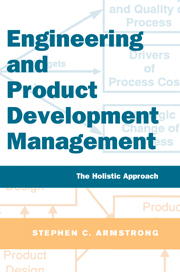Book contents
- Frontmatter
- Contents
- List of figures and tables
- Forewords
- Preface
- Acknowledgments
- Layout of book at a glance
- PART 1 UNDERSTANDING ENGINEERING PROCESS MANAGEMENT
- PART 2 APPLYING ENGINEERING PROCESSES TO PROGRAM MANAGEMENT
- PART 3 DEPLOYING ENGINEERING PROCESS MANAGEMENT
- 12 Organizing for deployment
- 13 Overcoming resistance to change
- 14 Implementing IPD – Lessons learned case study
- PART 4 APPENDIXES
- Glossary
- References
- Index
12 - Organizing for deployment
Published online by Cambridge University Press: 05 April 2014
- Frontmatter
- Contents
- List of figures and tables
- Forewords
- Preface
- Acknowledgments
- Layout of book at a glance
- PART 1 UNDERSTANDING ENGINEERING PROCESS MANAGEMENT
- PART 2 APPLYING ENGINEERING PROCESSES TO PROGRAM MANAGEMENT
- PART 3 DEPLOYING ENGINEERING PROCESS MANAGEMENT
- 12 Organizing for deployment
- 13 Overcoming resistance to change
- 14 Implementing IPD – Lessons learned case study
- PART 4 APPENDIXES
- Glossary
- References
- Index
Summary
Implementing the concepts outlined in this book is a major program that will affect and involve people from all areas of the company. The purpose of this chapter is to examine the people-oriented side of planning, organizing, developing, and implementing the changes outlined in this book. Implementing broad-based change to the engineering process represents one of the highest cost/potential payback improvement programs that can be undertaken at any company. A successful product development improvement initiative is the result of careful planning and organizing by the people responsible for deploying the new system. Most engineering executives know the theory of IPD and Concurrent Engineering, but few successfully deploy the concepts efficiently.On top of that, the company doesn't realize the commercial benefits. It is critical that sufficient planning occur before deployment.
The process of planning involves setting goals, selecting and developing methods for achieving those goals, and presenting the plan to begin its execution. These steps are discussed, along with other points necessary to begin the implementation.
INITIATIVE PROGRAM ORGANIZATION
The process of organizing consists of
❍ Specifying the task to be performed
❍ Breaking down of the total task into manageable segments
❍ Establishing clear responsibilities
❍ Selecting people to execute the task
Because success of the program is directly related to how it is managed, executive management should be involved in program organization. They should guide the development of the strategies to implement the changes at the company.
- Type
- Chapter
- Information
- Engineering and Product Development ManagementThe Holistic Approach, pp. 191 - 207Publisher: Cambridge University PressPrint publication year: 2001



